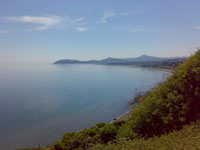County Wicklow Dublin
 County Wicklow is the southern neighbour of County Dublin and a major destination for day trips by Dubliners. Both locals and tourists come out here to visit historical sites like Glendalough and Powerscourt. Dubliners also like to go to Brittas Bay for a day by the sea and a barbecue in the sand dunes. County Wicklow is the southern neighbour of County Dublin and a major destination for day trips by Dubliners. Both locals and tourists come out here to visit historical sites like Glendalough and Powerscourt. Dubliners also like to go to Brittas Bay for a day by the sea and a barbecue in the sand dunes.
History Of Wicklow
The remote valleys and ridges of Wicklow have for centuries been a stronghold of Gaelic clans contesting the English rule over Ireland. County Wicklow was established in 1606 by the English to focus efforts on controlling these local clans. The land for this new county, incidentally the last to be established in Ireland, came from County Dublin and County Carlow. The failed 1798 rebellion took place in the Wicklow Mountains and the first road to cross the mountains was the Military Road built by the English to move troops faster from Dublin to centres of insurgency. You can drive along the Military Road today, travelling through unspoiled wilderness over the Sally Gap pass and enjoy great views over the city of Dublin.
Wicklow Today
Despite its proximity to Dublin, County Wicklow has large unpopulated areas and stretches of unspoiled nature. The Wicklow Mountains National Park is one of the biggest nature reserves in Ireland. Much of the remaining woodland outside the park hides elegant country homes and large estates. There are no larger cities and only few towns in Wicklow. Bray, 20 kilometres South of Dublin and just within Wicklow borders, is the county's biggest conurbation.
Glendalough
Glendalough is an early medieval monastery which commandeers a magical location between two mountain lakes in a narrow glacial valley studded with thick pine forests. The Irish name Gleann Dá Loch appropriately means Glen of Two Lakes. Hermit priest St. Kevin founded the monastery in the 7th century and it became an important centre for religious pilgrimage and learning until the complex was destroyed by English troops in 1398. Key parts of the monastery were restored during the 19th century, such as the 30 metres high Round Tower. Walking through the complex, you get a good impression of what the monastery might have looked like in the middle ages. Try to come out here either very early or late in the day, avoiding the crowds at peak times. Glendalough is a big tourist draw and the crowds can seriously put in on you experience of this otherwise serene and peaceful site. There is no direct public transport link from Dublin to Glendalogh but St Kevin's, a local private company, runs a coach service between Dublin and Glendalough.
www.glendalough.ie
www.glendaloughbus.com
Powerscourt
Powerscourt was established by the Normans as a stronghold in the fiercely independent Wicklow Mountains. The castle was extended over the centuries with the biggest makeover taking place during the 18th century, which resulted in the dominance of Palladian architecture you can see in Powerscourt today. The house burnt down in 1974 and has since been painstakingly restored. Powerscourt houses a collection of gift and design shops and a good restaurant and cafe run by Avoca. From the restaurant terrace you can enjoy great views over the formal 18th century gardens and the Sugarloaf mountain in the distance. The lands of the estate also harbour Ireland's highest waterfall, the 121 metres high Powerscourt Waterfall. To visit Powerscourt by public transport, take the Dart to Bray and the 185 bus to Enniskerry. It's a good 15 minutes' walk uphill from picturesque Enniskerry village to the gates of the estate. Alternatively, take the 44C bus directly from Townsend Street in Dublin's city centre to Enniskerry.
www.powerscourt.ie
Wicklow Mountains
The Wicklow Mountains are a rugged, sparsely populated mountain range that starts just outside the outskirts of Dublin and runs across County Wicklow into County Wexford. The highest peak in the range is Lugnaquilla with 925 metres. A large part of the area is covered by the Wicklow Mountains National Park. Established in 1991, the National Park is one of the biggest in Ireland and currently covers more than 170 square kilometres.
www.wicklowmountainsnationalpark.ie
Brittas Bay
Brittas Bay is one of the most scenic beaches on Ireland's East Coast with its 5 kilometres of golden sands and sweeping dunes. Brittas has won the European Blue Flag for clean beaches five years in a row. There are no cars allowed on the beach. Car parks are located outside the dune belt and you will face a good 10 minutes' uphill walk over the dunes to get to the beach. It's worth the effort. Brittas is a popular destination for daytrips by Dublin city dwellers. Many Dublin families keep mobile homes or more spectacular villas behind the dunes as holiday homes.
How To Get To Wicklow
The Dart local railway service from Dublin services Bray and Greystones in North County Wicklow. Dublin Bus operates several routes to villages and towns on the Northern fringes of the county. Bus Eireann runs regular coach services to all parts of Wicklow. Major tourist attractions like Powerscourt and Glendalogh are also serviced from Dublin by private tour companies, particularly during the summer months.
|